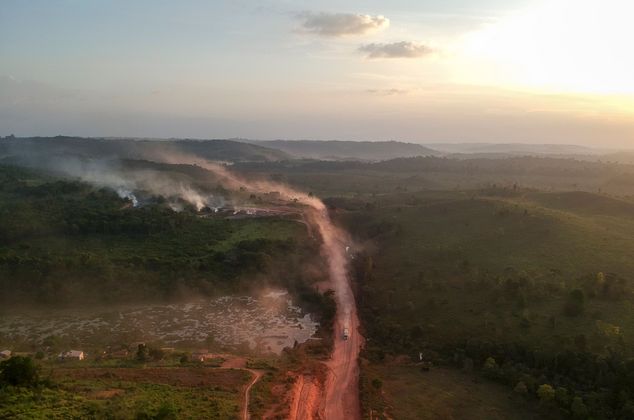Colombia

Prototyping for a Green Transformation in Colombia
Colombian smallholders in the protected areas affected by illicit coca cultivation are teaching us they can make a living legally and at the same time respect and protect the natural environment.
In 2021, coca bushes were cultivated on approximately 204,000 hectares in Colombia, according to UNODC data. About half of the plants grow in protected areas or so-called indigenous territories. The farmers who illegally cultivate coca in the protected areas are marginalised in many ways: economically, politically and socially. The remote nature reserves lack infrastructure, market access, schools and health care, and the state as a protective power is hardly present. The drug dealers initially supply the communities with coca seeds and later buy the harvests directly from them. Dealing with local dealers is often the only way for families to earn an income. They are faced with a dilemma: they have to survive, but in doing so they cause massive damage to the environment and permanently destroy their own livelihoods.
Illicit cultivation damages the natural habitat many ways: the farmers clear the primary forest to make room for farmland. When coca is processed into cocaine, a process that usually takes place on site, harmful chemicals are used that settle in soils and rivers. Coca cultivation pushes the so-called agricultural frontier deeper and deeper into protected areas, because illicit cultivation attracts more settlers and (illegal) sectors, and drug money is laundered through other agricultural activities such as cattle ranching. The direct and indirect impacts on the local ecosystem are devastating.
Sustainable economy and nature conservation
The GPDPD has been combining drug and environmental policies into a green drug policy in Colombia since 2015. On behalf of the Federal Ministry for Economic Cooperation and Development (BMZ) in collaboration with the Colombian Government, the United Nations Office on Drugs and Crime (UNODC) as well as regional and local partners, we have implemented eight Alternative Development projects in Putumayo, Caquetá, Guaviare, Nariño, Meta, and Valle del Cauca. By 2018, the partners implemented five projects under the bilateral cooperation programme on Protection of Forests and the Climate (REDD+). Coca-driven deforestation was the main issue to address.
In collaboration with UNODC, two additional projects on sustainable and legal forest management have been implemented after 2018, and the use of Payment for Environmental Services in National Parks areas is on its way. These projects are complemented by studies and policy recommendations for the Colombian government in collaboration with the Fundación Ideas para la Paz (FIP) for a green drug policy.
In order to make the special issue "Environmental impacts of illicit economies" of the Journal on Illicit Economies and Development accessible to Spanish-speaking stakeholders, a Spanish edition was produced exclusively with the help of the Center for Security and Drugs Studies (CESED) at the University of Los Andes. CESED and GPDPD have also jointly developed a digital tool that can be used by Colombian authorities interested in developing projects to pay for environmental services. The tool helps to select the most suitable areas based on some criteria established for each project.
All voices are brought in
The aim is to promote legal and sustainable value chains that also contribute to the regeneration and protection of the forest. In line with the Alternative Development approach, local authorities, producer associations, and smallholders are closely involved in the projects. This not only strengthens smallholders’ role in the transformation process but is also a success factor for the projects.
The small-scale farmers are already generating more income through the projects by sustainably using and marketing local fruits such as açaí, cocoa, or coffee cultivation. The farmers have been trained in sustainable management and environmentally sustainable farming methods. They receive support in obtaining certification for their products and in entering into fair trade agreements with local companies. This helps them obtain higher prices and some of the products are even sold by national companies on international markets in Europe and the USA.
Figures | Data | Facts
Alternatives to agricultural use
In the protected areas and special administrative regions for Afro-Colombians and indigenous peoples, even stricter regulations apply to agriculture - up to and including a complete ban. This poses particular challenges for alternative development projects. But here, too, there are approaches that are proving their worth in practice and are being incorporated into studies and policy recommendations. Some particularly promising initiatives include ecotourism and payments to local communities for maintaining their local ecosystems.
Small-scale farmers in Alternative Development projects in Colombia teach us how green drug policies can lead to a lasting transformation in affected regions. With their experiences, they create new prototypes for contemporary drug policies.

Germany, Colombia and Peru: Joint efforts to protect the environment
Colombia and Peru face a common challenge: illicit coca cultivation in nature reserves threatens their biodiversity. Both countries have made great efforts to reduce coca cultivation. However, national parks, forest reserves and buffer zones continue to suffer from the spread of illicit cultivation. As part of the German Government's Regional Fund for Triangular Cooperation, Colombia and Peru have agreed to jointly develop and implement measures that will benefit the 29 affected nature reserves in both countries.




![[Translate to English:] [Translate to ES:] [Translate to EN:] © GIZ / Leslie Searles [Translate to English:] [Translate to ES:] [Translate to EN:] © GIZ / Leslie Searles](/fileadmin/_processed_/5/a/csm_giz91_silvia_ipaguirre_0100a1808e.jpg)